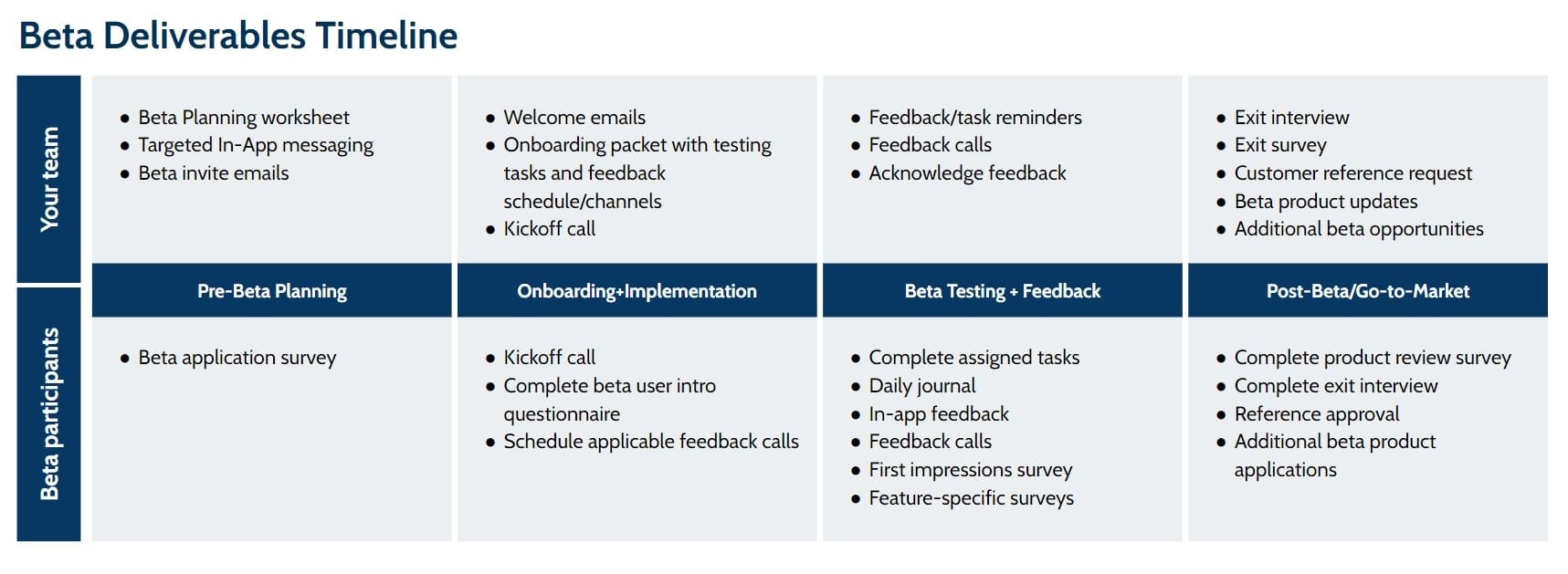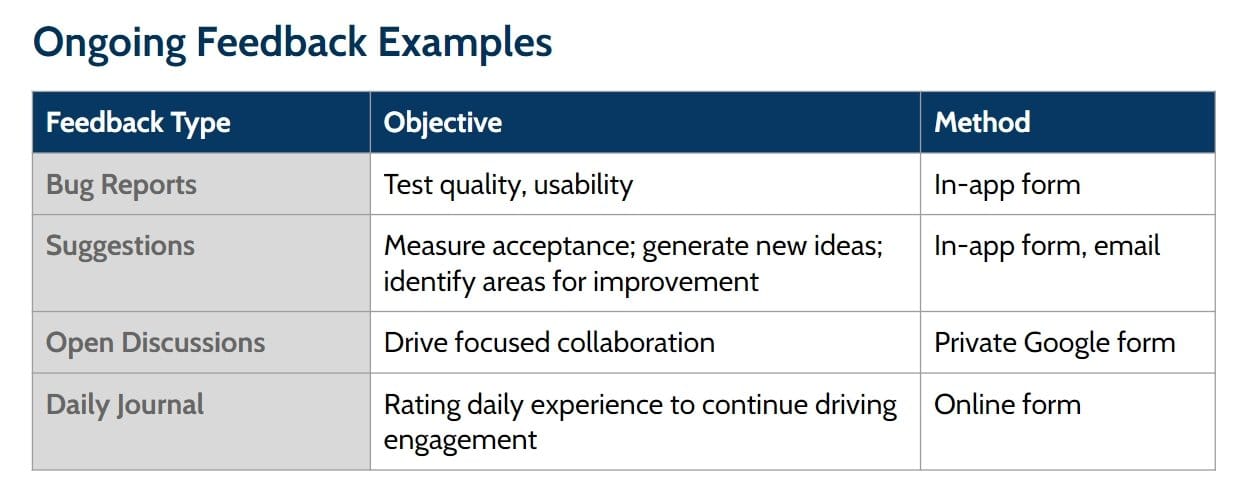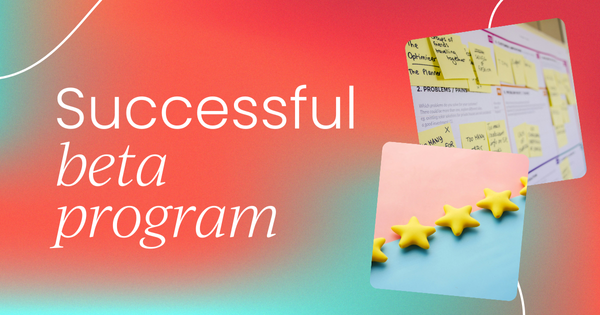Your team has worked tirelessly to build and refine a new product, and you're nearing your target launch date. But even if you've used customer feedback to guide your work, how do you ensure it matches their needs and expectations?
In-house testing can help you stress test a product's functionality, but eventually, you'll need to evaluate it in real-world circumstances. A beta program can help validate your early-stage product with end-users and give you insights to continue iterating your development.
What is a beta?
The beta is often the first time customers can see and interact with new software/features, providing a valuable opportunity for customer feedback on design, functionality, and usability.
A structured, robust beta program ensures your team receives valuable feedback and requires careful management from beginning to end.
A successful beta can be broken down into four key stages:
- Pre-beta planning
- Beta onboarding and implementation
- Testing and feedback
- Post-beta analysis and communications
We'll look at the objectives for each stage and identify some best practices to help you achieve them.

You can think of your beta as the first launch of your product, so you'll need to work with teams from across your organization to define goals and how to achieve them.
Your beta should aim beyond QA and usability testing to evaluate your product's viability in new real-life use cases. Some questions you might consider while planning include:
- When will it start and end?
- What are the desired outcomes of the beta? How will you measure them?
- What kind of customers do you want to participate?
- What type of feedback do you need, and how will you collect it?
- How will you introduce the new product or feature to beta users?
The length of the beta will depend on the objectives you and your internal stakeholders set. A beta program can run for a defined amount of time, until you reach specific satisfaction scores, or hit adoption metric goals, such as the number of issues identified, beta NPS score, or survey/feedback completion rate.
The success of the beta relies not only on the number of testers but the quality of the feedback.
You should assume that most beta users won't provide feedback, so collaborate with customer-facing teams, such as sales and customer success, to identify a diverse set of candidates with whom you have solid relationships.
Try to maintain a wide range of personas and industries, as this will help the upcoming beta launch as well as future tests.
We have partnered with Fluvio to provide extensive B2B and B2C product marketing expertise for software and technology companies looking to find product-market fit and deliver sustainable growth.
Together, we can offer a suite of products and services to help you scale more effectively and efficiently throughout each stage of your lifecycle.
Beta onboarding and implementation
After you’ve identified the ideal candidate set, you'll need a sustainable invitation process to launch your beta.
Depending on the scope of the beta, this could be anything from a short email from the product team to an abbreviated version of your go-to-market launch with templates for marketing automation, landing pages, and follow-ups from your customer success team.
Once you have a pipeline of potential beta participants, you'll need to select the right users and set their expectations as beta testers. Start with a customer survey to identify key beta partners/stakeholders, potential feature usage, and technical requirements. This data will help you select the candidates most likely to provide consistent, helpful feedback.
Onboarding the selected participants will help them understand the features they are testing and the product feedback process.
Whether in a kickoff call or a welcome packet, the onboarding should include information about the length of the beta, feedback channels, and meeting cadences.
Setting these expectations early in the process will let users know that you value their time and insights — and hopefully encourage more feedback.
Testing and collecting feedback
Every beta user is different; some users will actively explore and engage every corner of the features, while others will quickly forget they exist. Build steps into your beta launch process to encourage adoption and drive feedback.
Utilize in-app messaging to create a first-time use reminder that thanks them for being a part of the beta and show them the features they will be testing.
Provide an outline of tasks and activities for them to try so that users don't feel lost in the new tools, and you'll gain insights on specific functionality. Set up automated email reminders for users to log in and reinforce how valuable their input is.
You should also find ways to make providing feedback easy but also comprehensive. Set up different channels for different types of feedback to encourage users to participate as much or as little as they want.
Schedule interviews throughout critical stages of the beta to get a customer's voiceover on their feedback and provide an opportunity for dialogue and discussion.

Post beta analysis and communications
Your beta phase is more than simply testing whether or not a product works; it's an additional opportunity to research how well it fits with user and market needs, and to identify what adjustments are needed before you bring it to market.
Key takeaways from a beta test can include feature improvements, product adoption/stickiness, product-market fit, and willingness to pay. Use this analysis to see if your product meets the required KPIs for a go/no-go decision to bring it to market.
The beta is also an opportunity to provide another positive experience for customers. From their point of view, users want to know that their feedback helps shape the product's development, so keep an open line of communication about relevant fixes that result directly from customer feedback.
Closing the loop helps beta testers, who are often your most ardent supports, know that you value them throughout the development process.
Don't limit your feedback and improvements to the featured product; spend some time asking your testers about the process itself. Find out their preferences for meetings (e.g. weekly, biweekly, monthly) and communications channels (e.g. phone, email) and measure their overall satisfaction with a beta-program NPS survey.
Remember to thank your users for their time and insights and keep them engaged to have an eager pool of customers for future tests. While the beta stage is here to help iterate a product's development, the process itself also needs continual nurturing and improvement to give you the best insights for development.


















 Follow us on LinkedIn
Follow us on LinkedIn



.svg?v=85af970283)